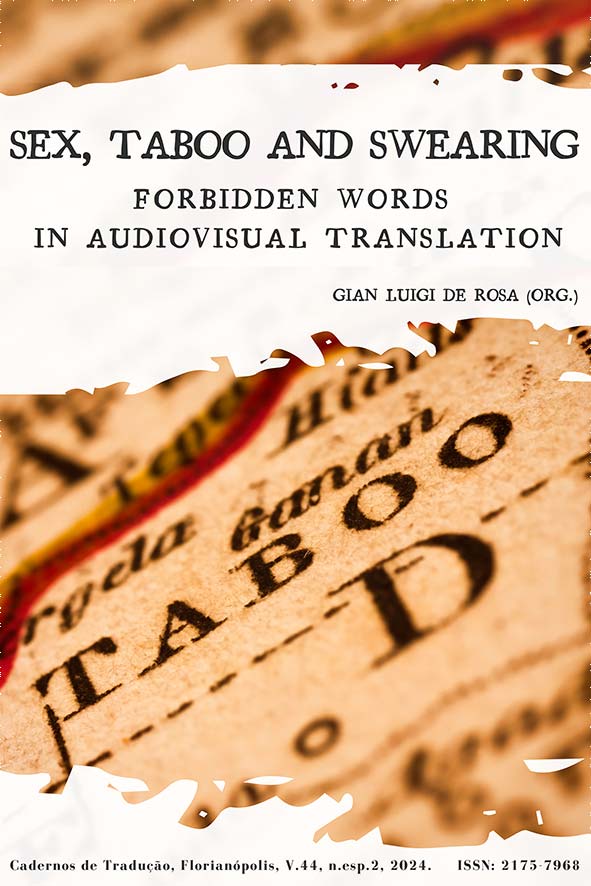Palavrões e turpilóquios à vontade: os serviços de streaming e a atualização das normas de tradução para legendagem
DOI :
https://doi.org/10.5007/2175-7968.2024.e99146Mots-clés :
tradução audiovisual, legendagem interlinguística, normas de tradução, serviços de streamingRésumé
Redes e canais de TV tradicionais, como RTP [Rádio e Televisão de Portugal] e SIC [Sociedade Independente de Comunicação] em Portugal e Globosat e HBO [Home Box Office] no Brasil, têm uma abordagem mais conservadora em suas diretrizes gerais de legendagem no que diz respeito à norma padrão da língua (Ramos Pinto, 2010) e ao uso de palavrões e turpilóquios (HBO, 2001). Entre as orientações gerais para os tradutores de legendas estão, por exemplo, amenizar a linguagem de baixo calão e respeitar a norma culta do português. Com a chegada da Netflix ao mercado de legendagem, notou-se um afrouxamento dessas regras. O serviço de streaming permite o uso de palavrões sem qualquer tipo de censura e a redação de legendas mais idiomáticas e coloquiais (Netflix, 2023). O presente artigo pretende identificar orientações explícitas ou implícitas que justifiquem essa mudança de abordagem na confecção das legendas do serviço de streaming para o português. Para isso, procedemos ao levantamento e à análise das diretrizes gerais de legendagem de dois provedores de conteúdo audiovisual: HBO Latin America (2001) e Netflix (2023), lançando mão do conceito de normas de tradução (Toury, 1978) para detectar três conjuntos distintos de normas que atualmente coexistem no sistema de tradução audiovisual do português. O artigo discute ainda se as traduções amadoras, que costumam ignorar os parâmetros profissionais da indústria, exigem do espectador um esforço cognitivo maior. Como conclusão, sugerimos três explicações para o comportamento não normativo por parte dos tradutores da Netflix: (1) o desconhecimento das normas restritivas de outros agentes da indústria de legendagem, pois, com o advento da Netflix, uma nova geração de tradutores entrou no mercado; (2) o fato de os assinantes do serviço de streaming terem voz ativa na produção e na pós-produção dos programas que consomem; (3) as diretrizes linguísticas menos normativas da Netflix de fato deram espaço a um maior grau de liberdade às soluções tradutórias.
Références
Aslam, S. (2023, Abril 9). YouTube by the Numbers: Stats, Demographics & Fun Facts. Omnicoreagency.com.
Bogucki, L. (2016). Areas and Methods of Audiovisual Translation Research. Peter Lang.
Brennan, L. (2018, Outubro 12). How Netflix Expanded to 190 Countries in 7 Years. Hbr.org.
D’Ydewalle, G., Rensbergen, J. V., & Pollet, J. (1987). Reading a Message When the Same Message Is Available Auditorily in Another Language: The Case of Subtitling. In J. K. O'Regan & A. Lévy-Schoen (Eds.), Eye Movements: From Physiology to Cognition (pp. 313–21). North Holland.
Ghoshal, A. (2017, Março 31). Netflix wants to pay you to translate subtitles. Thenextweb.com.
Gottlieb, H. (1998). Subtitling. In M. Baker (Ed.), Routledge Encyclopedia of Translation Studies (pp. 244−248). Routledge.
HBO Latin America Production Services, L.C. (2001). SUBTITLING: SPECIFICATIONS, GUIDELINES and STANDARDS. [Documento fotocopiado sem autor].
Jenkins, H. (2004). The Cultural Logic of Media Convergence. International Journal of Cultural Studies, 7(1), 33–43. https://doi.org/10.1177/1367877904040603
Jones, D. (2010, Novembro 12). Sherlock - storytelling through visual text. iheartsubtitles.wordpress.com
Lång, J. (2016). Subtitles vs. Narration: The Acquisition of Information from Visual-Verbal and Audio-Verbal Channels When Watching a Television Documentary. In S. Hansen-Schirra & S. Grucza (Eds.), Eye-tracking and Applied Linguistics (pp. 59−82). Language Science Press.
McClarty, R. (2012). Towards a Multidisciplinary Approach in Creative Subtitling. MonTI: Monografías de Traducción e Interpretación, (4), 133–153. https://doi.org/10.6035/MonTI.2012.4.6
Netflix Partner Help Center. (Acesso em 2023). Brazilian Portuguese Timed Text Style Guide.
Netflix Partner Help Center. (Acesso em 2023). Timed Text Style Guide: General Requirements.
Nornes, A. M. (1999). For an Abusive Subtitling. Film Quarterly, 52(3), 17–34. https://doi.org/10.2307/1213822
O’Hagan, M. (2009). Evolution of User-Generated Translation: Fansubs, Translation Hacking and Crowdsourcing. The Journal of Internationalization and Localization, 1(1), 94–121. https://doi.org/10.1075/jial.1.04hag
Orrego-Carmona, D. (2018). New Audiences, International Distribution, and Translation. In E. Di Giovani & Y. Gambier (Orgs.), Reception Studies and Audiovisual Translation (pp. 321−342). John Benjamins.
Paz, J. (2018, Dezembro 2). Gols do Fantástico em série americana? As traduções mais bacanas da TV paga. Noticiasdatv.uol.com.br.
Pedersen, J. (2018). From Old Tricks to Netflix: How Local Are Interlingual Subtitling Norms for Streamed Television? Journal of Audiovisiual Translation, 1(1), 81–100. https://doi.org/10.47476/jat.v1i1.46
Perego, E., Del Missier, F., Porta, M., & Mosconi, M. (2010). The Cognitive Effectiveness of Subtitle Processing. Media Psychology, 13(3), 243–272. https://doi.org/10.1080/15213269.2010.502873
Pérez-González, L. (2012). Amateur Subtitling as Immaterial Labour in Digital Media Culture: An Emerging Paradigm of Civic Engagement. Convergence: The International Journal of Research into New Media Technologies, 19(2), 157–175. https://doi.org/10.1177/1354856512466381
Pym, A. (2008). On Toury’s Laws of How Translators Translate. In A. Pym, M. Shlesinger & D. Simeoni (Eds.), Beyond Descriptive Translation Studies: Investigations in homage to Gideon Toury, (pp. 311−328). https://doi.org/10.1075/btl.75.24pym
Ramos Pinto, S. (2010). Tradução No Vazio: A Variação Linguística Nas Traduções Portuguesas de Pygmalion, de Bernard Shaw, e My Fair Lady, de Alan Jay Lerner. [Tese de Doutoramento]. Universidade de Lisboa, Faculdade de Letras.
Robinson, D. (1998). 22 Theses on Translation. Journal of Translation Studies, 2, 92–117.
Toury, G. (1978). The Nature and Role of Norms in Translation. In L. Venuti (Ed.), The Translation Studies Reader (pp. 198−211). Routledge.
Venuti, L. (2017). The Translator’s Invisibility: A History of Translation. Routledge.
Téléchargements
Publiée
Comment citer
Numéro
Rubrique
Licence
(c) Tous droits réservés Cadernos de Tradução 2024

Ce travail est disponible sous la licence Creative Commons Attribution 4.0 International .
Autores têm autorização para assumir contratos adicionais separadamente, para distribuição não exclusiva da versão do trabalho publicada nesta revista (ex.: publicar em repositório institucional ou como capítulo de livro, com reconhecimento de autoria e publicação inicial nesta revista).





















































